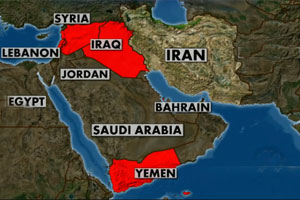As the ceasefire in Yemen came to an end, airstrikes against Houthi militias were resumed on May 18. On the same day, the Yemen national congress was held in Riyadh where 400 politicians from various political currents participated, the sole party absent were the Houthis that are guided by the Iranian regime, al-Jazeera TV reported.
Despite international condemnation of the Iranian regime’s interference in Yemen, this regime continues to aid the Houthis.
Not a long time ago, people of Yemen were united. However, it was the dictatorial regime in Iran that introduced sectarianism in Yemen.
Last June, Khamenei ordered the terrorist Qods Force (QF) to speed up the plan for occupation of Sanaa and to control Yemen by the Houthis. Following the initiation of operation “Decisive Storm”, a classified QF document stipulated that it is two years now that the IRGC has transferred all sorts of weaponry to the Houthis in Yemen, including a large number of surface-to-surface and surface-to-sea missiles, and thus they have no problem of shortage of missiles and weaponry.
On October 19, 2014, Khamenei’s foreign affairs adviser Ali Akbar Velayati, in his meeting with a group of Houthis in Tehran titled “Yemeni scholars and cultural figures”, noted: “In Yemen, Ansarullah should play the very role that Hezbollah is playing in Lebanon.”
In a message in March to the Arab conference, Maryam Rajavi, the leader of the Iranian opposition, stated that the coalition against occupation of Yemen should be extended to the eviction of the Iranian regime from throughout the region.
Mrs. Rajavi brought the attention of Arab leaders to this important fact that the warmongering of the clerical regime in the Middle East is not from a position of strength but is aimed at cloaking its irremediable domestic political, social and economic crises. She reiterated that in face of resoluteness, this regime will retreat. Similarly, appeasement and concessions embolden this regime in its aggressions. The root cause of the crises in this region is the Iranian regime and the ultimate solution is the overthrow of this regime by the Iranian people and their resistance.
Aref Abu Hatam, a political analyst in Cairo, stated in his interview with al-Arabiya TV on May 21: “Sectarian mindset depletes the society of its values. Before, we had never heard of differentiating between Shiites and Sunnis in Yemen. The Houthis that appeared with the mindset and ideology of the Iranian regime targeted the roots of Yemen. They targeted the peaceful coexistence, brotherhood and humanitarianism among the Yemeni people. The schism that Houthis created in Yemen requires many years to mend.”
This analyst added that the Houthis and the forces affiliated with the former President Ali Abdullah Saleh are massacring the people. According to Hatam, the Iranian regime is working with the Houthis in Yemen, with Hezbollah in Lebanon, and with the Popular Mobilization Force (PMF) in Iraq to advance its plans. The Iranian regime does not work diplomatically with countries, but works through its criminal groups and the political parties that are affiliated with it.
Najib Ghalab, a political analyst in Riyadh told al-Arabiya: “The Houthis and any group that the Iranian regime supports have a joint plan to instigate sectarianism which is a tool to destroy political currents in favor of the Iranian regime. Houthis are ruthless and their mentality is based on oppression and violence. They are a tool in the hands of the Iranian regime.”
The Iranian regime needs to be stopped if peoples of the Middle East are to be emancipated from their suffering caused by the mullahs sitting in Tehran. The bloodletting in so many countries will stop when the head of the fundamentalism- and extremism-serpent is smashed in Tehran and the current religious fascism is replaced by a democratic, peaceful and non-nuclear republic.



